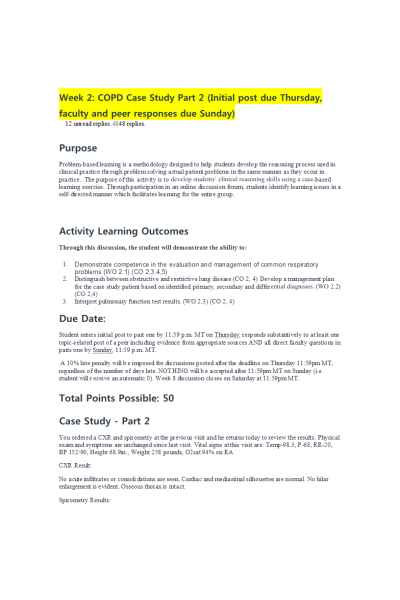NR 601 Week 2 COPD Case Study - Part 2 (Initial post, Faculty and Peer Responses)
-
$15.00
| Institution | Chamberlain |
| Contributor | Chantara |
Purpose
Problem-based learning is a methodology designed to help students develop the reasoning process used in clinical practice through problem solving actual patient problems in the same manner as they occur in practice. The purpose of this activity is to develop students’ clinical reasoning skills using a case-based learning exercise. Through participation in an online discussion forum, students identify learning issues in a self-directed manner which facilitates learning for the entire group.
A 10% late penalty will be imposed for discussions posted after the deadline on ..., regardless of the number of days late. NOTHING will be accepted after ... (i.e. student will receive an automatic 0). Week 8 discussion closes on ...
Case Study - Part 2
You ordered a CXR and spirometry at the previous visit and he returns today to review the results. Physical exam and symptoms are unchanged since last visit. Vital signs at this visit are: Temp-98.3, P-68, RR-20, BP 152/90, Height 68.9in., Weight 258 pounds, O2sat 94% on RA
CXR Result: No acute infiltrates or consolidations are seen. Cardiac and mediastinal silhouettes are normal. No hilar enlargement is evident. Osseous thorax is intact.
Spirometry Results:
| |||||||||||||||||||||||||||||||||||
Requirements/Questions:
- What is your primary (one) diagnosis for this patient at this time? (support the decision for your diagnosis with pertinent positives and negatives from the case)
- Identify the corresponding ICD-10 code.
- Provide a treatment plan for this patient's primary diagnosis which includes:
- Medication*
- Any additional testing necessary for this particular diagnosis*
- Patient education
- Referral
- Follow up
- Provide an active problem list for this patient based on the information given in the case.
- Are there any changes that you would also make to this patient’s overall treatment plan at this time? Must provide an EBP argument for each treatment or testing decision.
*If part of the plan does not warrant an action, you must explain why. ALL medication and testing decisions (or decisions not to treat with medication or additional testing) MUST be supported with an evidence-based practice (EBP) argument. Over-the-counter (OTC) and RXs must be written in full as if handing a script to the patient in the office.
Over-the-counter (OTC) and RXs must be written in full as if handing a prescription to the patient in the office.
Example:
- Amoxicillin 500 mg capsule
- 1 tab po BID q 10 days
- Disp #20 no refills
| Instituition / Term | |
| Term | Summer 2020 |
| Institution | Chamberlain |
| Contributor | Chantara |
























































